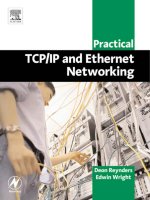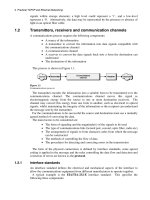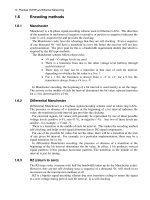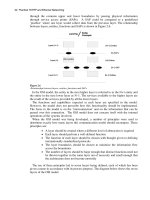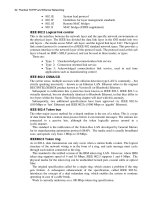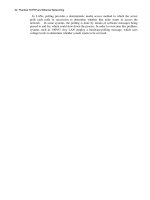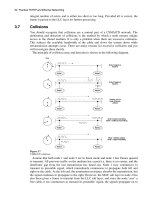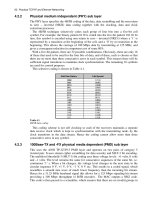Practical TCP/IP and Ethernet Networking- P39 ppt
Bạn đang xem bản rút gọn của tài liệu. Xem và tải ngay bản đầy đủ của tài liệu tại đây (293.64 KB, 5 trang )
6XGIZOIGR:)6/6GTJ+ZNKXTKZ4KZ]UXQOTM
85;:+
The route command is used to configure network routing tables. This may be a tedious
task but is sometimes necessary for reasons of security or because a specific route has to
be added.
The following shows the route options.
C:\WINDOWS.000>route /?
Manipulates network routing tables.
ROUTE [-f] [command [destination] [MASK netmask] [gateway] [METRIC metric]]
-f Clears the routing tables of all gateway entries. If this is used
in conjunction with one of the commands, the tables are
cleared prior to running the command.
command Must be one of four:
PRINT Prints a route
ADD Adds a route
DELETE Deletes a route
CHANGE Modifies an existing route
destination Specifies the destination host.
MASK Specifies that the next parameter is the ‘netmask’ value.
netmask Specifies a subnet mask value to be associated with this route
entry. If not specified, it defaults to 255.255.255.255.
METRIC Specifies that the next parameter ‘metric’ is the cost for this
destination
All symbolic names used for destination are looked up in the network database file
NETWORKS. The symbolic names for gateway are looked up in the host name database
file HOSTS.
If the command is PRINT or DELETE, wildcards may be used for the destination and
gateway, or the gateway argument may be omitted.
Diagnostic notes:
Invalid MASK generates an error, that is when (DEST & MASK) != DEST.
Example> route ADD 255.0.0.0 157.0.0.0 MASK 155.0.0.0
157.55.80.1
The route addition failed: 87
Examples:
> route PRINT
> route ADD 157.0.0.0 MASK 255.0.0.0 157.55.80.1 METRIC 3
^destination ^mask ^gateway ^metric
> route PRINT
> route DELETE 157.0.0.0
> route PRINT
C:\WINDOWS.000>
The route table exists on both hosts and routers. An individual entry is read from left to
right as follows: ‘If a message is destined for network 192.100.100.0, with subnet mask
255.255.255.0, then route it through to the gateway address 192.100.100.1’. Remember
that a HostID equal to 0, as used here, does not refer to a specific host but rather to the
network as a whole.
Routes can also be added with the route add and route delete commands.
Route add 192.100.100.0 mask 255.255.255.0 192.100.100.1 will add a route and
Route delete 192.100.100.0 will delete a particular route. Manual adding of routes are
sometimes necessary, for example in the case where the installation of dial-up proxy
:)6/6[ZOROZOKY
server software on a given host sometimes overwrites the existing default gateway setting
on that host in order to ‘point’ to the Internet service provider’s default gateway. This
makes it impossible for the host to reach an existing adjacent network across the
intermediate router, unless a manual entry is made. If said entry ‘does the job’ but
disappears when the host is re-booted, the appropriate route command needs to be
included in the autoexec.bat file.
The following response was obtained from the route print command.
Active routes:
Network Address Netmask Gateway Address Interface Metric
127.0.0.0 255.0.0.0 127.0.0.1 1 27.0.0.1 1
207.194.66.96 255.255.255.224 207.194.66.100 207.194.66.100 1
207.194.66.100 255.255.255.255 127.0.0.1 127.0.0.1 1
207.194.66.255 255.255.255.255 207.194.66.100 207.194.66.100 1
224.0.0.0 224.0.0.0 207.194.66.100 207.194.66.100 1
255.255.255.255 255.255.255.255 207.194.66.100 0.0.0.0 1
C:\WINDOWS.000>
:NK.59:9LORK
The hosts file is used on UNIX and Windows systems to resolve the mapping of a ‘name’
(any given name) to an IP address.
The following is an example of a typical Windows hosts file. This file is saved in the
same directory as Windows itself as c:\windows\hosts. If a user is uncertain about the
correct format of the entries, a sample file can be found at c:\windows\hosts.sam. Note
that, as a matter of convenience, the hosts sample file can be edited as in the
accompanying example, but it MUST then be saved as hosts only, i.e. without the.
same extension.
In the example, host 192.100.100.2 can simply be interrogated by typing ping john.
Figure 9.6
The Hosts file (courtesy of Microsoft Corporation)
10
LAN system components
Objectives
When you have completed this chapter you should be able to:
• Explain the basic function of each of the devices listed under 10.1
• Explain the fundamental differences between the operation and application
of switches (layer 2 and 3), bridges and routers
10.1 Introduction
In the design of an Ethernet system there are a number of different components that can
be used. These include:
• Repeaters
• Media converters
• Bridges
• Hubs
• Switches
• Routers
• Gateways
• Print servers
• Terminal servers
• Remote access servers
• Time servers
• Thin servers
The lengths of LAN segments are limited due to physical and collision domain
constraints and there is often a need to increase this range. This can be achieved by
means of a number of interconnecting devices, ranging from repeaters to gateways. It
may also be necessary to partition an existing network into separate networks for reasons
of security or traffic overload.
LAN system components 175
In modern network devices the functions mentioned above are often mixed:
• A shared 10BaseT hub is, in fact, a multi-port repeater
• A layer II switch is essentially a multi-port bridge
• Segmentable and dual-speed shared hubs make use of internal bridges
• Switches can function as bridges, a two-port switch being none other than a
bridge
• Layer III switches function as routers
These examples are not meant to confuse the reader, but serve to emphasize the fact
that the functions should be understood, rather than the ‘boxes’ in which they
are packaged.
10.2 Repeaters
A repeater operates at the physical layer of the OSI model (layer 1) and simply
retransmits incoming electrical signals. This involves amplifying and re-timing the
signals received on one segment onto all other segments, without considering any
possible collisions. All segments need to operate with the same media access mechanism
and the repeater is unconcerned with the meaning of the individual bits in the packets.
Collisions, truncated packets or electrical noise on one segment are transmitted onto all
other segments.
10.2.1 Packaging
Repeaters are packaged either as stand-alone units (i.e. desktop models or small cigarette
package-sized units) or 19" rack-mount units. Some of these can link two segments only,
while larger rack-mount modular units (called Concentrators) are used for linking
multiple segments. Regardless of packaging, repeaters can be classified either as local
repeaters (for linking network segments that are physically in close proximity), or as
remote repeaters for linking segments that are some distance apart.
Figure 10.1
Repeater application
10.2.2 Local Ethernet repeaters
Several options are available:
• Two-port local repeaters offer most combinations of 10Base5, 10Base2,
10BaseT and 10Base-FL such as 10Base5/10Base5, 10Base2/10Base2,
10Base5/10Base2, 10Base2/10BaseT, 10BaseT/10BaseT and 10Base-
FL/10Base-FL. By using such devices (often called boosters or extenders)
one can, for example, extend the distance between a computer and a
10BaseT hub by up to 100 m, or extend a 10Base-FL link between two
devices (such as bridges) by up to 2 km
176 Practical TCP/IP and Ethernet Networking
• Multi-port local repeaters offer several ports of the same type (e.g. 4×
10Base2 or 8× 10Base5) in one unit, often with one additional connector of a
different type (e.g. 10Base2 for a 10Base5 repeater). In the case of 10BaseT
the cheapest solution is to use an off-the-shelf 10BaseT shared hub, which is
effectively a multi-port repeater
• Multi-port local repeaters are also available as chassis-type units; i.e. as
frames with common back planes and removable units. An advantage of this
approach is that 10Base2, 10Base5, 10BaseT and 10Base-FL can be mixed
in one unit, with an option of SNMP management for the overall unit. These
are also referred to as Concentrators
10.2.3 Remote repeaters
Remote repeaters, on the other hand, have to be used in pairs with one repeater connected
to each network segment and a fiber-optic link between the repeaters. On the network
side they typically offer 10Base5, 10Base2 and 10BaseT. On the interconnecting side the
choices include ‘single pair Ethernet’, using telephone cable up to 457 m in length, or
single mode/multimode optic fiber, with various connector options. With 10Base-FL
(backwards compatible with the old FOIRL standard), this distance can be up to 1.6 km.
In conclusion it must be emphasized that although repeaters are probably the cheapest
way to extend a network, they do so without separating the collision domains, or network
traffic. They simply extend the physical size of the network. All segments joined by
repeaters therefore share the same bandwidth and collision domain.
10.3 Media converters
Media converters are essentially repeaters, but interconnect mixed media viz. copper and
fiber. An example would be 10BaseT/10Base-FL. As in the case of repeaters, they are
available in single and multi-port options, and in stand-alone or chassis type
configurations. The latter option often features remote management via SNMP.
Figure 10.2
Media converter application
Models may vary between manufacturers, but generally Ethernet media converters
support:
• 10 Mbps (10Base2, 10BaseT, 10Base-FL – single and multi-mode)
• 100 Mbps (fast) Ethernet (100Base-TX, 100Base-FX – single and
multimode)
• 1000 Mbps (gigabit) Ethernet (single and multimode)
An added advantage of the fast and gigabit Ethernet media converters is that they
support full-duplex operation that effectively doubles the available bandwidth.
